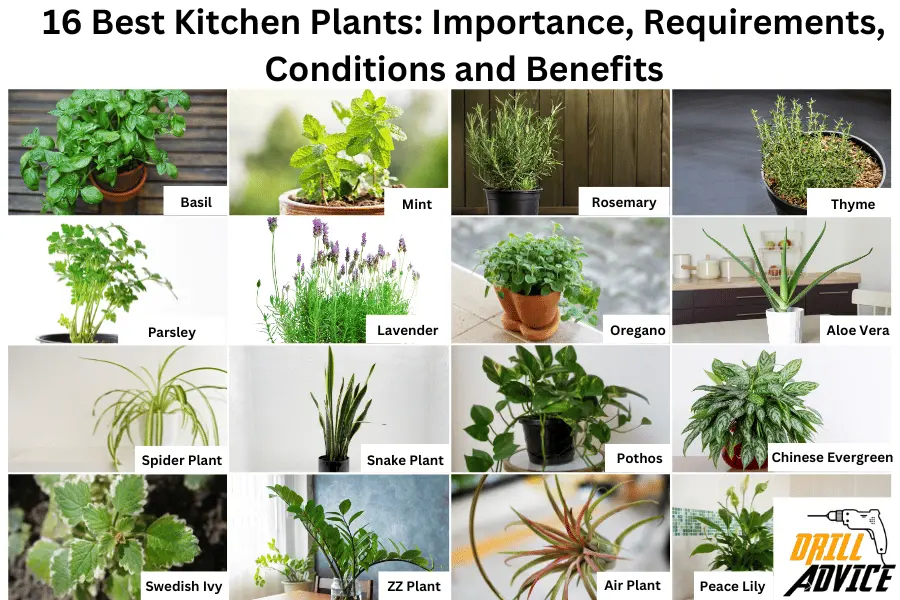
Growing a plant in the kitchen can improve the aesthetic view of the kitchen and the health condition of the kitchen. Kitchen plants are mainly two types those are herbal plants and decorative plants. Kitchen plants are important because they can purify the air inside the kitchen, control the kitchen inside humidity, improve the aesthetic appeal, improve the functional utility, improve natural fragrance and reduce mental stress.
These are the 16 best kitchen plants you should grow in the kitchen. These are Basil, Mint, Rosemary, Thyme, Parsley, Lavender, Oregano, Aloe Vera, Spider Plant, Snake Plant, Pothos, Chinese Evergreen, Swedish Ivy, ZZ Plant, Air Plant, Peace Lily
When you choose a plant for the kitchen, you should consider these things such as importance and the types of the plant, water, sunlight requirement, growing speed, color, growing place, insect attraction, toxicity, pet friendliness, advantages and disadvantages of the plants.
You should not grow plants related to these categories in the kitchen, such as plants toxic to humans and pets, high maintenance plants, prone to pest infestation, plants with drop leaves and debris, larger plants, strong scent plants, plants with high humidity, and fruit-bearing plants.
What are the 7 Importance of Kitchen Plants?
The most 7 importance of kitchen plants are air purification, humidity control, aesthetic enhancement, functional utility, natural fragrance, connection to nature, and stress reduction. These important factors help keep the kitchen environment clean and healthy.
7 Importance of Kitchen Plant
- Air Purification:
- The Kitchen consists of fumes, odors, and airborne grease from cooking activities. Kitchen plants can absorb pollutants and toxins and improve indoor air quality.
- Humidity Control:
- Cooking can change the kitchen’s humidity due to boiling and steaming processes. Plants naturally release water vapour through transpiration and help to balance and regulate the kitchen’s humidity while ensuring comfort.
- Aesthetic Enhancement:
- Plants can add aesthetic appeal from the colour, texture, and vibrancy, making meal preparation and dining a more pleasant experience while enhancing the visual dynamics of the kitchen.
- Functional Utility:
- Generally, herbal plants bring two benefits such as space decoration and providing fresh ingredients.
- Natural Fragrance:
- Due to some cooking activities inside kitchen has less pleasant smells. Some plants can act as natural deodorizers, releasing pleasant aromas that can mask or neutralize unwanted odours in the kitchen.
- Connection to Nature:
- Modern kitchens are filled with stainless steel appliances and electronic gadgets, and that can sometimes give a sterile feeling. By incorporating plants, we can get a touch of nature, creating a more harmonious and organic atmosphere.
- Reduction of Stress:
- A small kitchen can be a busy place when the meals are prepared. But plants can provide visual relief and promote a sense of well-being because the presence of greenery can reduce stress.
Read More About – 10 Ways to Improve Kitchen Ventilation: Bad Effects, Importance and Methods
What Should Consider Before Grow a Plant in the Kitchen?
Before growing a plant in the kitchen, you should consider the impact of the plant and its advantages. As the impact of the plant, you should consider water, sunlight, maintenance requirements, growing place, toxicity, insect attraction, pet friendliness, and disadvantages of the plant. The advantages of the kitchen plant are air purification, insect repelling, aesthetic appeal and functional usage.
- Importance of the Plant:
- Before Selecting a plant for the kitchen, you should know whether the plant is herbal, flowering, or ornamental. It helps to determine its primary function in the kitchen.
- Sunlight Requirement:
- Sunlight is a major requirement for the growth of the plant in the kitchen. Some plants need direct sunlight, while others may prefer indirect or minimal light. Understanding this and adjusting your kitchen to provide the appropriate lighting conditions can enhance the growth of the plant the plant’s growth.
- Water Requirement:
- Knowing the exact water amount needed for the growth of the plant needs can dictate where it should be placed and how often you need to treat it.
- Growing Speed:
- Having knowledge about the growth speed of kitchen plants will make the maintenance processes much easier. Because Fast-growing plants might require frequent trimming or repotting, while slower-growing plants might be more suitable for those wanting a low-maintenance option.
- Color:
- The color and aesthetic appeal of a plant can influence the ambiance of a kitchen. For example, bright green can add vibrancy, while variegated hues can add depth and texture. Therefore it is important to match the plant’s look with your kitchen’s design.
- Growing Place:
- The available space in your kitchen will determine the size and type of plant that can be accommodated according to the space accused by the plant to grow.
- Insect Attraction:
- Some plants might attract pests. The kitchen can be less healthy if the insect can live there. So being aware of potential insect attraction helps in taking preventive measures.
- Toxicity:
- In a kitchen, where food preparation occurs, it’s essential to ensure that plants are non-toxic, especially if there are chances of them being ingested accidentally.
- Pet Friendliness:
- If you have pets, it’s essential to ensure that the plant won’t harm them if ingested or touched. Some plants can be toxic to cats, dogs, or other animals.
- Advantages:
- Understanding the benefits of a plant, such as air purification, aesthetic appeal, and functional use, can help in making an informed decision based on your priorities.
- Disadvantages:
- Being aware of potential drawbacks, such as high maintenance, potential for pests, or seasonal sensitivities, ensures you’re prepared for any challenges.
What are the 16 Types of Kitchen Plants?
The 16 types of kitchen plants are,
- Basil
- Mint
- Rosemary
- Thyme
- Parsley
- Lavender
- Oregano
- Aloe Vera
- Spider Plant
- Snake Plant
- Pothos
- Chinese Evergreen
- Swedish Ivy
- ZZ Plant
- Air Plant
- Peace Lily
1. Basil
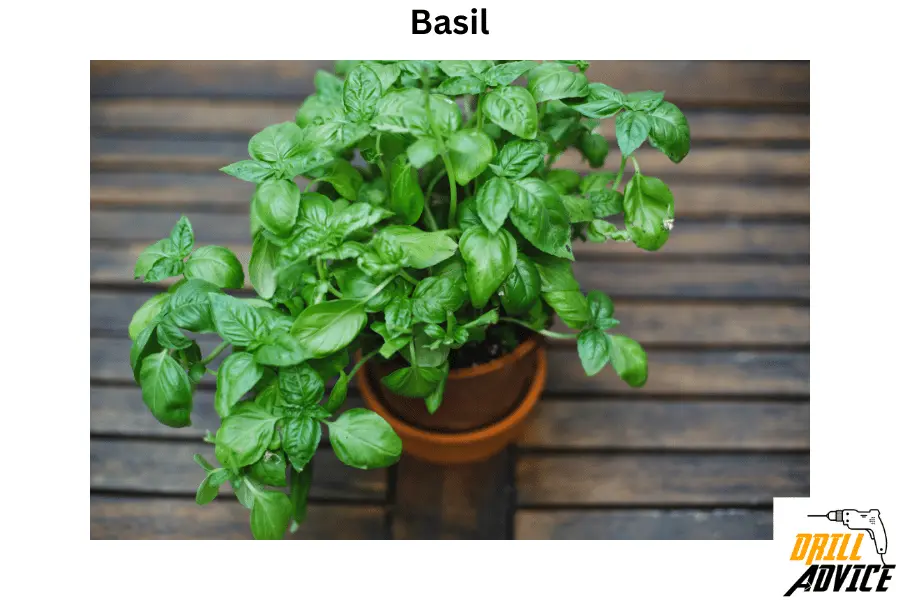
Scientific Name: Ocimum basilicum
Importance of the Plant and Type: Basil is a herbal plant that can be planted in the kitchen for culinary purposes. It’s popular in a wide range of dishes, especially in Italian cuisine. You can use fresh basil when you plant in the kitchen.
Sunlight Requirement: Basil requires 6 to 8 hours of sunlight daily. A south-facing window in the kitchen is suitable for the basil. If you don’t have sufficient natural sunlight, consider using a grow light.
Water Requirement: Water the basil in the kitchen when the top inch of the soil feels dry. Overwatering can cause root rot. Typically, watering every other day is sufficient, but this can vary based on sunlight and the size of the pot.
Growing Speed: Basil grows quickly. Depending on the variety, it can reach maturity in as little as 3 to 4 weeks. Regular pruning or harvesting of the top leaves can encourage bushier growth. If flowering occurs, pinch off the flowers to promote leaf production.
Color: Basil is usually a vibrant green, though there are varieties like ‘Purple Basil’ with deep purple leaves.
Aesthetic View: Its bright green color can add a fresh, lively ambience to a kitchen.
Growing Place: A sunny windowsill or countertop in the kitchen is the best place for basil. Ensure the pot has good drainage and consider using a saucer to prevent any water damage to the surfaces in the kitchen
Insect Attraction: Basil can attract aphids or whiteflies. Regularly check the plants in the kitchen and consider using natural remedies or insecticidal soap if an infestation occurs.
Toxicity: Basil is non-toxic to both humans and pets. Hence it is good to plant in the kitchen.
Pet Friendliness: Basil is pet-friendly. While it’s non-toxic, large amounts may cause mild stomach upset in pets if consumed, so it’s always best to keep an eye on them.
Advantages:
- Culinary Benefits: Fresh basil can enhance numerous dishes.
- Aesthetic Appeal: Basil can add a touch of greenery and life to the kitchen.
- Aromatherapy: Basil has a delightful aroma that can be refreshing in the kitchen.
Disadvantages:
- Requires Regular Attention: Basil needs consistent care in terms of sunlight and watering.
- Potential Insect Attraction: As mentioned, basil can sometimes attract pests.
- Seasonality: Basil is a warm-season herb, which means it may not thrive in colder months or climates without additional care or indoor growing conditions.
2. Mint
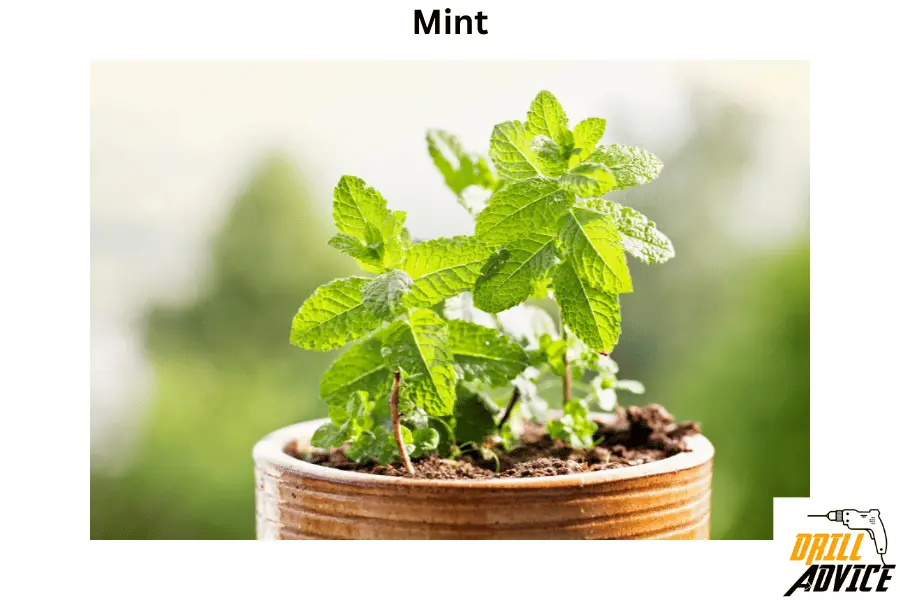
Scientific Name: Mentha spicata
Importance of the Plant: Mint is an aromatic herb that falls under the category of culinary herbs. It adds a fresh and refreshing aroma to your kitchen space and can be used in a variety of culinary dishes, teas, and beverages.
Sunlight Requirement: Mint plants thrive in bright, indirect sunlight. They require about 4 to 6 hours of sunlight per day. You should place the mint plant in the kitchen near a window that receives filtered sunlight.
Water Requirement: You should water your mint plant in the kitchen whenever the top inch of soil feels dry to the touch. Ensure proper drainage to prevent waterlogging, as overly wet soil can lead to root rot.
Growing Speed: Mint is a fast-growing herb that can become quite bushy if not properly pruned. To control its growth in the kitchen and encourage bushiness, regularly pinch back the tips of the stems. This also helps maintain its fresh flavour.
Color: Mint plants typically have vibrant green leaves, adding a splash of natural color to your kitchen. The lush green foliage can enhance the aesthetic appeal of your kitchen space.
Growing Place: Choose a spot in your kitchen where the mint plant can receive sufficient sunlight and proper air circulation. Placing it near a window or on a sunny countertop in the kitchen is a good decision.
Insect Attraction: Mint plants are known for their strong aroma, which can repel some insects. However, they can still attract pests like aphids and spider mites. Regularly inspect the leaves for any signs of pests and take appropriate measures to control them.
Toxicity: Mint plants are generally non-toxic to humans and pets when consumed in small amounts. However, the strong menthol aroma and flavor might not be appealing to some pets.
Pet Friendliness: Mint is considered safe for most pets when consumed in moderation. However, due to its potent aroma and taste, some pets may not be interested in nibbling on it.
Advantages:
- Culinary Uses: Mint leaves can be used to add flavor to a wide range of dishes, desserts, and beverages.
- Aromatic Ambiance: The refreshing scent of mint can naturally freshen the air in your kitchen.
- Easy to Grow: Mint is relatively easy to grow, making it a great choice for beginners.
Disadvantages:
- Invasive Growth: Mint has a tendency to grow rapidly and can become invasive if not properly contained.
- Rootbound Plants: Mint plants can become rootbound in small containers.
- Prone to Diseases: Mint plants can be susceptible to fungal diseases, especially if the leaves remain wet for extended periods.
3. Rosemary
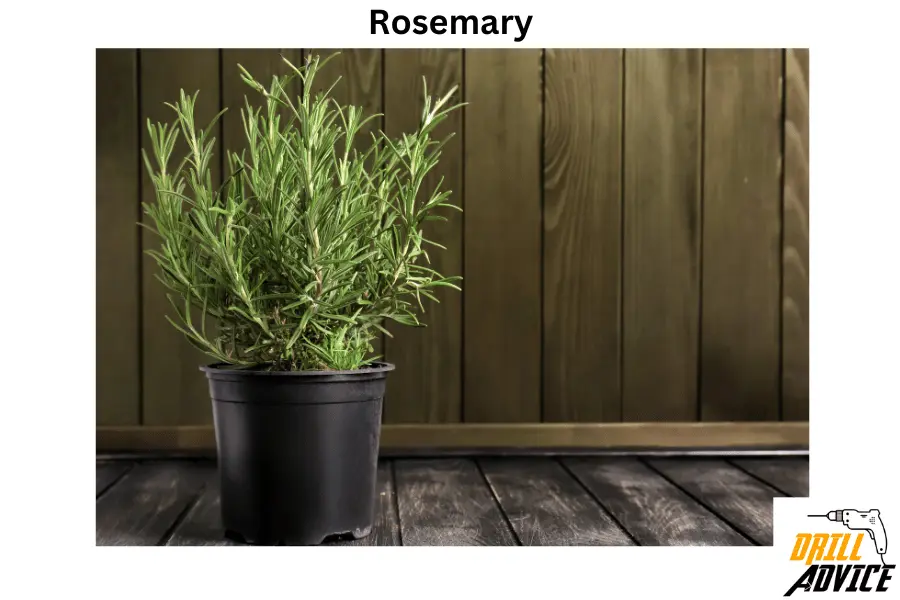
Scientific Name: Rosmarinus officinalis
Importance of the Plant: Rosemary is a woody herb that adds a delightful aroma and a distinct flavor to a variety of culinary dishes. It is also known for its potential health benefits and its use in natural remedies.
Sunlight Requirement: Rosemary thrives in bright sunlight. It requires at least 6 to 8 hours of direct sunlight each day. Place your rosemary plant near a south-facing window or under grow lights to ensure it receives adequate light when you plant in the kitchen.
Water Requirement: Water the rosemarry plant thoroughly but less frequently, as it is susceptible to root rot in overly moist conditions.
Growing Speed: Rosemary is a slow-growing herb compared to some others. Regular pruning is recommended to encourage branching and maintain a compact shape while in the kitchen.
Color: Rosemary features needle-like leaves that are typically dark green in color, adding a touch of natural elegance to your kitchen.
Growing Place: Choose a sunny and well-ventilated spot in your kitchen to place the rosemary plant. It should be away from drafts and cold windows during winter months.
Insect Attraction: Rosemary is generally resistant to many common pests due to its strong aroma. However, occasional pests like aphids and spider mites may still be attracted to the plant. You should regularly inspect the plant in the kitchen to prevent infestations.
Toxicity: Rosemary is considered safe for humans and pets when used in culinary amounts. However, its essential oil should be used with caution and not ingested in large quantities.
Pet Friendliness: Rosemary is generally safe for most pets. However, as with any plant, it’s best to discourage excessive nibbling by pets.
Advantages:
- Culinary Versatility: Rosemary’s aromatic leaves can enhance a wide range of dishes, from roasted meats to vegetable dishes and marinades.
- Aromatic Ambiance: The pleasant fragrance of rosemary can add a refreshing and invigorating scent to your kitchen.
- Longevity: Rosemary plants can live for several years with proper care, providing a consistent supply of fresh herbs.
Disadvantages:
- Slow Growth: Rosemary takes time to establish and grow compared to some other herbs.
- Pruning Requirements: Regular pruning is necessary to prevent the plant from becoming too leggy and to encourage healthy growth.
- Sensitive to Overwatering: Overwatering can lead to root rot and damage the plant’s health.
4. Thyme
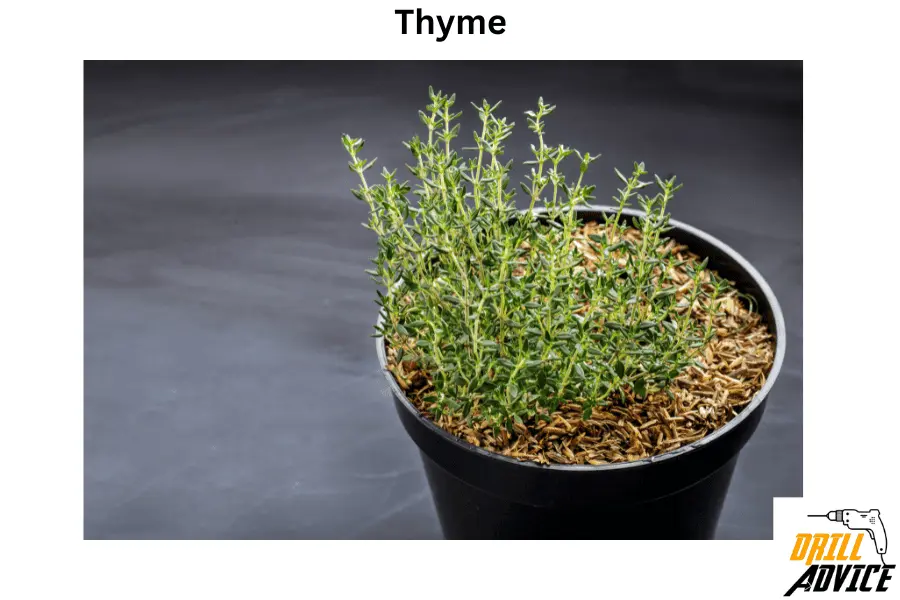
Scientific Name: Thymus vulgaris
Importance of the Plant: Thyme is a versatile herb known for its aromatic leaves and culinary uses. When it plants in the kitchen, it can add depth of flavor to various dishes and be used for its potential health benefits.
Sunlight Requirement: Thyme thrives in bright sunlight. It requires about 5 to 8 hours of direct sunlight each day. Place your thyme plant in the kitchen where a sunny windowsill or provide supplemental lighting if needed.
Water Requirement: Thyme prefers well-draining soil and should be watered moderately. Allow the top inch of soil to dry out between waterings. Overwatering can lead to root rot, so ensure proper drainage to remove the excess water.
Growing Speed: Thyme is a relatively slow-growing herb. Regular pruning helps maintain its shape and encourages new growth.
Color: Thyme features small, narrow leaves that are typically green or variegated, contributing a subtle yet appealing touch of greenery to your kitchen.
Growing Place: Choose a sunny spot in your kitchen where the thyme plant can receive ample sunlight. Consider using a well-draining potting mix to ensure the plant’s roots stay healthy.
Insect Attraction: Thyme is generally resistant to many pests due to its strong fragrance. However, it can still attract pests like aphids or spider mites.
Toxicity: Thyme is safe for human consumption in culinary amounts. However, its essential oil should be used with caution and not ingested in large quantities. It is generally non-toxic to pets as well.
Pet Friendliness: Thyme is considered safe for most pets when consumed in small quantities. However, some pets may not find the taste appealing.
Advantages:
- Culinary Enhancement: Thyme’s aromatic leaves add depth and complexity to a variety of dishes. It can be used for roasted meats, soups, and stews.
- Aromatic Ambiance: The pleasant scent of thyme can create a soothing and inviting atmosphere in your kitchen.
- Low Maintenance: Thyme requires minimal care once established, making it suitable for busy individuals.
Disadvantages:
- Slow Growth: Thyme takes time to establish and grow in the kitchen with limited sunlight.
- Pruning Requirements: Regular pruning is necessary to maintain its shape and encourage new growth.
- Size Limitations: Thyme plants may not yield large quantities of leaves compared to other herbs.
5. Parsley
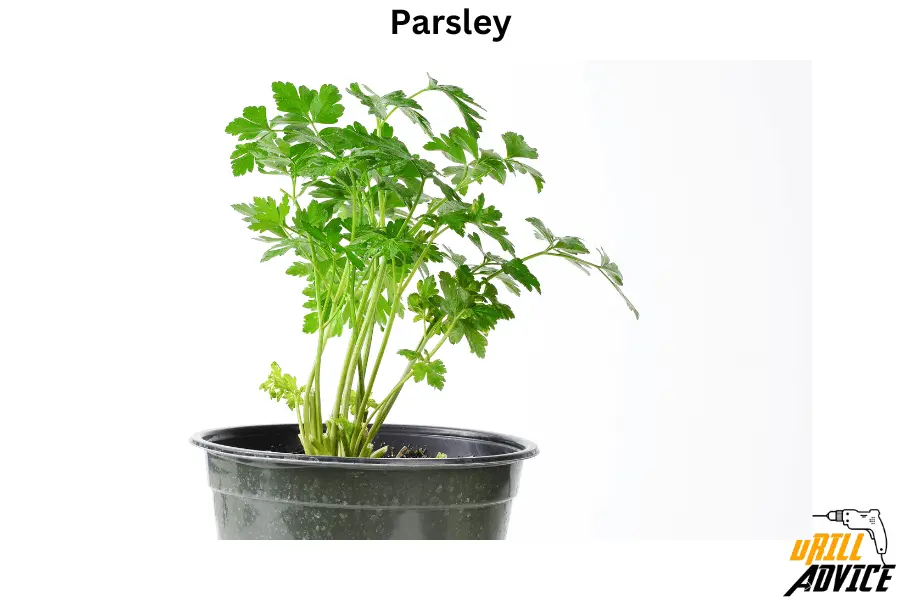
Scientific Name: Petroselinum crispum
Importance of the Plant: Parsley is an herb that belongs to the “herbal” category. It’s commonly used as a culinary ingredient to add flavor and freshness to dishes. It’s an essential herb in many cuisines due to its versatility and aromatic qualities. Therefore parsley is an important plant for the kitchen.
Sunlight Requirement: Parsley needs moderate to bright indirect sunlight. Placing it near a sunny window or on a countertop where it can receive around 4-6 hours of indirect sunlight per day is ideal. If your kitchen doesn’t have enough natural light, you might consider using a grow light to supplement the light requirements.
Water Requirement: Parsley prefers consistently moist soil. Water the plant when the top inch of soil feels dry to the touch. Ensure proper drainage to prevent waterlogging, which can lead to root rot.
Growing Speed: Parsley has a moderate growth rate. Regular harvesting by cutting outer leaves increase the growth rate and prevents the plant from spreading. It’s recommended to trim the outer leaves frequently to encourage bushier growth in the kitchen
Color: Parsley typically has bright green color, which can provide a refreshing and vibrant aesthetic to your kitchen. The lush green colour adds a natural touch to the kitchen area.
Growing Place: Place the parsley plant near a kitchen window as it can receive the required sunlight. If space is limited, consider placing it on a windowsill, countertop, or even hanging it in a hanging planter.
Insect Attraction: Parsley may attract common kitchen pests like aphids and whiteflies. Regularly inspect the plant for any signs of infestation, and if needed, gently wash the leaves with a mild soapy water solution to control pests.
Toxicity: Parsley is generally non-toxic to humans and pets when used as a culinary herb. However, consuming large amounts of parsley in concentrated forms (such as essential oils) could have adverse effects.
Pet Friendliness: Parsley is considered safe for most pets when used in moderation. However, it’s a good idea to prevent pets from excessively nibbling on the plant, as consuming large quantities might lead to digestive discomfort.
Advantages of Having Parsley in the Kitchen:
- Fresh Culinary Ingredient: Having parsley readily available allows you to enhance the flavors of your dishes with a burst of freshness.
- Aesthetic Appeal: The vibrant green color of parsley adds a touch of nature and visual appeal to your kitchen.
- Educational Opportunity: Growing parsley in the kitchen can serve as an educational experience for you and your family, teaching about plant care and growth.
Disadvantages of Having Parsley in the Kitchen:
- Pest Management: Parsley can attract pests.
- Limited Growth Space: If your kitchen has limited space, finding an appropriate spot for the parsley plant might be a challenge.
- Maintenance Required: Regular care and harvesting are needed to ensure the plant’s health. Therefore continuous maintenance is required.
6. Lavender

Scientific Name: Lavandula
Importance of the Plant for Kitchen: Lavender is a herbal plant that brings a delightful fragrance and visual appeal to the kitchen. It’s known for its calming and aromatic qualities, making it a perfect addition to a space where cooking and relaxation converge.
Sunlight Requirement: Lavender thrives in full sunlight. It needs at least 6-8 hours of direct sunlight per day to grow well and maintain its health in the kitchen.
Water Requirement: Lavender prefers well-draining soil and doesn’t like to be constantly damp. Water the plant when the top inch of soil feels dry, usually about once every 1-2 weeks, depending on the humidity levels in your kitchen.
Growing Speed: Lavender is a slow-growing plant. Prune it regularly to encourage bushier growth and to prevent it from becoming too spread. Pruning can be done every 2-3 months, depending on the growth rate in the kitchen
Color: Lavender plants have gray-green foliage and produce beautiful spikes of purple, blue, or white flowers, depending on the variety. The vibrant colors can add an aesthetic touch to your kitchen.
Growing Place: Place your lavender plant in a sunny windowsill or near a south-facing window in your kitchen. Make sure it receives ample sunlight throughout the day.
Insect Attraction: Lavender is known for its insect-repelling properties. While it attracts pollinators like bees and butterflies, it can help keep pests like flies, mosquitoes, and moths away from your kitchen.
Toxicity: Lavender is generally considered safe for humans. It’s used in various culinary and herbal preparations. However, while lavender is not highly toxic to pets, it’s advisable to keep it out of reach as consuming large amounts could lead to mild gastrointestinal discomfort.
Pet Friendliness: Lavender is mildly toxic to pets, especially cats and dogs. Ingesting lavender in small amounts might not cause severe harm, but it’s recommended to keep pets away from the plant to prevent any potential issues.
Advantages of Having Lavender in the Kitchen:
- Aromatic Ambiance: Lavender’s soothing scent can create a relaxing atmosphere in your kitchen, making cooking and dining a more pleasant experience.
- Natural Air Freshener: Lavender’s fragrance helps mask cooking odors and adds a natural, fresh aroma to the kitchen.
- Insect Control: Lavender’s insect-repelling properties can help keep unwanted pests at bay, ensuring a cleaner and more hygienic cooking environment.
Disadvantages of Having Lavender in the Kitchen:
- Limited Culinary Use: While lavender can be used in cooking, it has a strong flavor that might not suit all dishes. It’s essential to use it sparingly and in the right recipes.
- Pet Safety Concerns: Lavender can be harmful to pets if ingested in larger quantities, making it a potential risk if you have curious animals in the kitchen.
- Maintenance Needs: Lavender requires regular pruning and care to maintain its growth and appearance. If you’re not willing to invest time in its upkeep, it might not thrive as well as expected.
7. Oregano
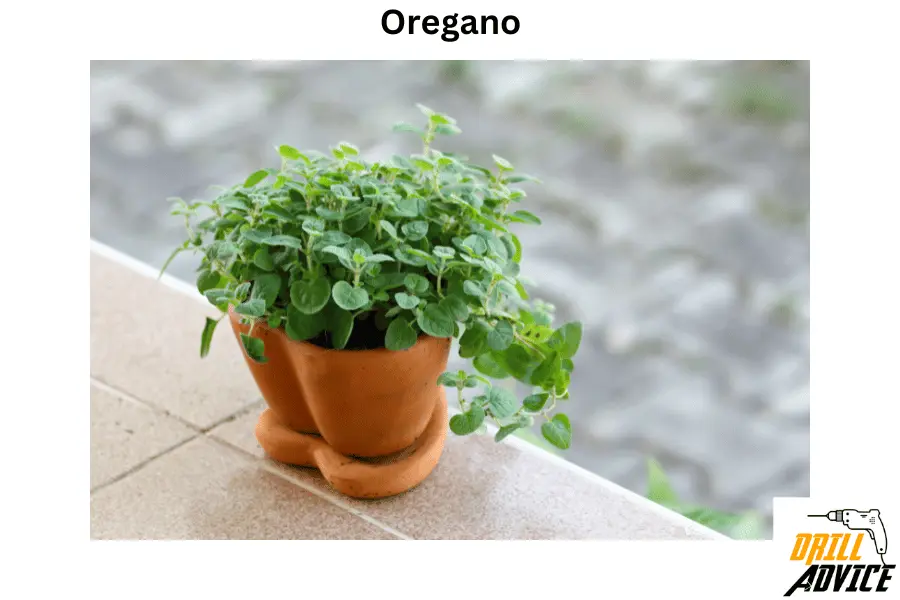
Scientific Name: Origanum vulgare
Importance of the Plant for Kitchen: Oregano is a culinary herb that adds a robust flavor to various dishes. It’s an essential ingredient in Mediterranean and Italian cuisines, making it a valuable addition to the kitchen for enhancing the taste of your meals.
Sunlight Requirement: Oregano thrives in full sunlight. It needs around 6 hours of direct sunlight daily, so placing it near a south-facing window or in a sunny spot in your kitchen is ideal.
Water Requirement: Oregano prefers well-draining soil. Water the plant when the top inch of soil feels dry. Generally, it needs watering every 1-2 weeks, but frequency may vary depending on factors like humidity and pot size when it place in the kitchen.
Growing Speed: Oregano is a moderately fast-growing herb. Regularly harvest the leaves to encourage new growth and prevent the plant from spreading.
Color: Oregano has small, green leaves that provide a subtle yet vibrant touch of greenery to your kitchen.
Growing Place: Choose a location in your kitchen where the oregano can receive plenty of sunlight throughout the day. A windowsill with good exposure to sunlight is an excellent option.
Insect Attraction: Generally, oregano is not attracting insects. In fact, its strong aroma can help repel certain pests, making it a useful addition to your kitchen garden.
Toxicity: Oregano is safe for human consumption and is commonly used as a culinary herb. It is not toxic to pets, making it a pet-friendly choice for your kitchen garden.
Pet Friendliness: Oregano is safe for pets and is unlikely to cause any harm when ingested in small quantities.
Advantages of Having Oregano in the Kitchen:
- Culinary Enhancement: Oregano’s distinct flavor complements a wide range of dishes, from pasta and pizza to salads and sauces, adding depth and aroma to your cooking.
- Freshness at Hand: Having oregano in the kitchen means you can easily access fresh leaves whenever you need them.
- Aesthetic Appeal: The vibrant green leaves of oregano can contribute to the aesthetic appeal of your kitchen space.
Disadvantages of Having Oregano in the Kitchen:
- Limited Space Requirement: Oregano can spread and take up space as it grows. If you have a small kitchen, it might require regular pruning to prevent it from becoming too large.
- Maintenance: Regular care, including pruning and watering, is necessary to ensure healthy growth and prevent the plant from becoming leggy or overgrown.
- Seasonal Growth: Oregano may slow down its growth during colder months or in low-light conditions, requiring extra attention to maintain its vitality during such periods.
8. Aloe Vera
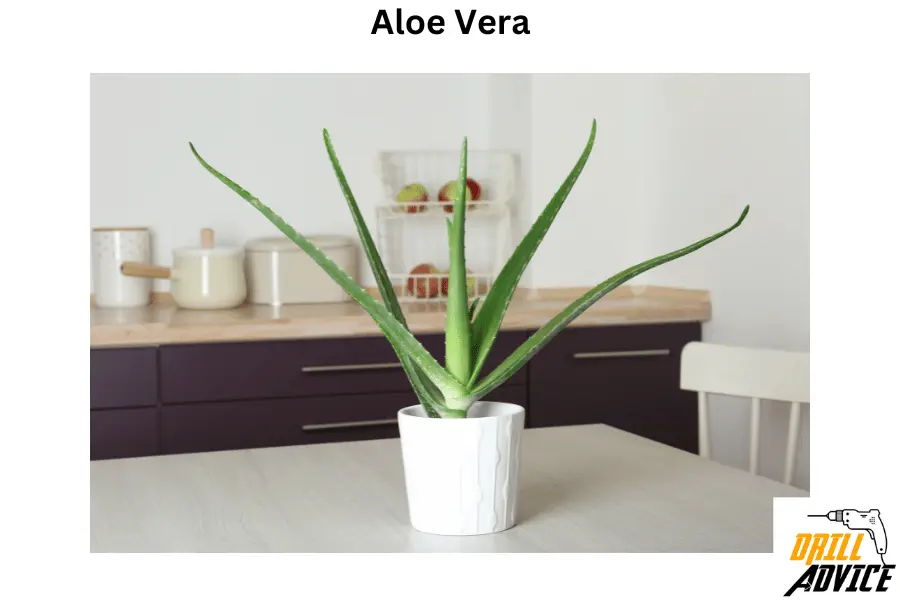
Scientific Name: Aloe barbadensis miller
Importance of the Plant for Kitchen: Aloe Vera is used for various medicinal and cosmetics purposes. Having an Aloe Vera plant in the kitchen can provide you with quick access to its healing properties for minor burns, skin irritations, and more.
Sunlight Requirement: Aloe Vera prefers bright, indirect sunlight. It can tolerate some direct sunlight, but too much intense light can lead to sunburn. Place it near a window with filtered light or provide it with some shade during the hottest parts of the day.
Water Requirement: Aloe Vera has minimal water requirements due to its succulent nature. Allow the top 2-3 inches of soil to dry out before watering, which is typically around every 2-3 weeks. Overwatering can lead to root rot.
Growing Speed: Aloe Vera is a slow-growing plant. It doesn’t require frequent pruning, but you can remove damaged or yellowing leaves as needed.
Color: Aloe Vera has thick, fleshy green leaves that can add a refreshing touch of green to your kitchen.
Growing Place: Position your Aloe Vera plant on a windowsill with filtered sunlight or any well-lit spot in your kitchen. Ensure it’s not exposed to prolonged direct sunlight, especially during hot afternoons.
Insect Attraction: Aloe Vera is not typically attractive to insects. Its thick leaves contain a bitter sap that deters most pests.
Toxicity: Aloe Vera gel, extracted from the inner leaf, is safe for topical use on humans and pets for minor skin irritations. However, the yellowish sap (aloin) found just beneath the leaf’s skin can have laxative effects when ingested, so it’s best to keep pets away from the plant.
Pet Friendliness: While the gel from Aloe Vera leaves can be used on pets’ skin for certain issues, it’s essential to prevent pets from chewing on the plant, as ingestion of the aloin sap can lead to digestive discomfort.
Advantages of Having Aloe Vera in the Kitchen:
- Natural First Aid: The gel inside Aloe Vera leaves is soothing and can be used to treat minor kitchen burns, cuts, and skin irritations.
- Air Purification: Aloe Vera helps improve indoor air quality by absorbing pollutants and releasing oxygen, contributing to a healthier kitchen environment.
- Low Maintenance: Aloe Vera’s minimal water and care requirements make it an easy-to-manage plant, perfect for busy kitchens.
Disadvantages of Having Aloe Vera in the Kitchen:
- Limited Culinary Use: Aloe Vera’s gel can have potential health benefits when ingested in moderation, but its bitter taste and potential laxative effects might not make it a suitable culinary ingredient for everyone.
- Large Size: Aloe Vera can grow relatively large over time, which might make it impractical for smaller kitchen spaces. Regular repotting or control of its growth might be necessary.
- Sensitive to Overwatering: Overwatering can lead to root rot and other issues, so it’s crucial to find the right balance when it comes to watering frequency.
9. Spider Plant

Scientific Name: Chlorophytum comosum
Importance of the Plant for Kitchen: The Spider Plant is an adaptable and low-maintenance houseplant that adds a touch of elegance to your kitchen space. Its unique foliage and air-purifying qualities make it a popular choice for both aesthetics and indoor air quality improvement.
Sunlight Requirement: Spider Plants thrive in indirect sunlight. They can tolerate some direct sunlight but prefer bright, filtered light.
Water Requirement: Spider Plants have moderate water requirements. Allow the top inch of soil to dry out before watering. Watering every 1-2 weeks is generally sufficient, but adjust based on the humidity of your kitchen.
Growing Speed: Spider Plants are relatively fast growers. They produce “spiderettes” or baby plants that can be propagated easily to create new plants. Prune the spent flowers and yellowing leaves to maintain a tidy appearance.
Color: Spider Plants have long, arching leaves with a green and white striped pattern. This unique coloration adds a touch of visual interest to your kitchen.
Growing Place: Place your Spider Plant on a shelf, countertop, or hanging planter in your kitchen. Ensure it receives bright, indirect light to support healthy growth.
Insect Attraction: Spider Plants are not known to attract insects significantly. In fact, they can help improve indoor air quality by reducing pollutants and toxins.
Toxicity: Spider Plants are non-toxic to humans and pets. They are safe to have in your kitchen, even if you have curious pets.
Pet Friendliness: Spider Plants are considered safe for pets. They are not toxic if ingested, making them a great choice for households with cats, dogs, or other animals.
Advantages of Having Spider Plant in the Kitchen:
- Air Purification: Spider Plants are excellent air purifiers, helping to remove toxins such as formaldehyde and xylene from the indoor air, leading to a healthier kitchen environment.
- Easy Care: Spider Plants are forgiving and require minimal maintenance, making them suitable for beginners or busy individuals.
- Aesthetic Appeal: The unique variegated foliage of the Spider Plant adds a decorative element to your kitchen decor, enhancing its overall visual appeal.
Disadvantages of Having Spider Plant in the Kitchen:
- Brown Tips: Spider Plants can develop brown tips on their leaves due to factors like dry air or irregular watering. Maintaining consistent humidity and watering practices can help prevent this issue.
- Limited Culinary Use: Spider Plants are primarily ornamental and not typically used for culinary purposes.
- Space Requirement: As Spider Plants produce “spiderettes,” they can gradually take up more space. Regular propagation or repotting might be necessary to control their growth.
10. Snake Plant
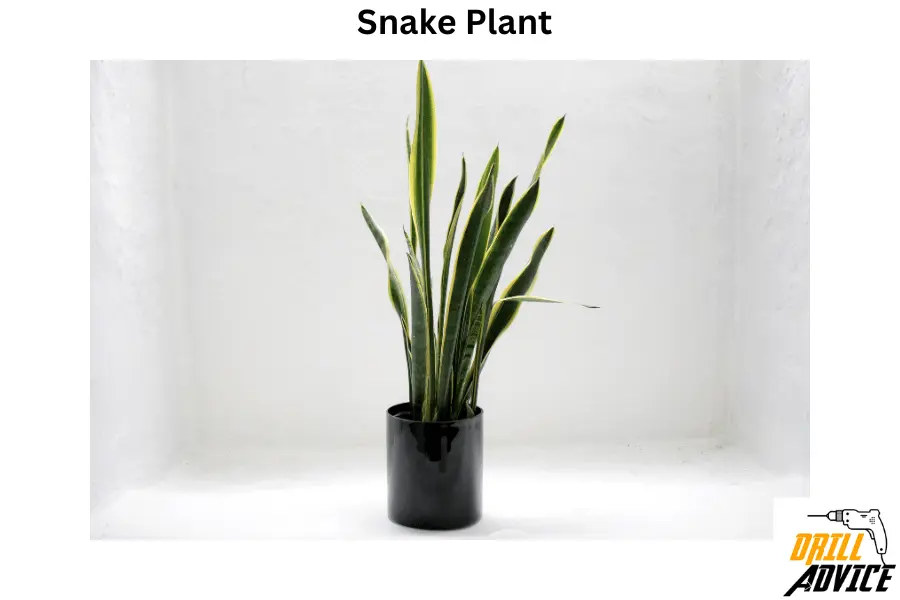
Scientific Name: Sansevieria trifasciata
Importance of the Plant for Kitchen: The Snake Plant, also known as the Mother-in-Law’s Tongue, is a popular choice for kitchen spaces due to its air-purifying qualities and ability to thrive in low-light conditions. Its unique appearance and low maintenance make it a practical and decorative addition to the kitchen.
Sunlight Requirement: Snake Plants thrive in low to moderate light conditions. They can tolerate low light and indirect sunlight, making them ideal for kitchens with limited natural light.
Water Requirement: Snake Plants have minimal water requirements. Allow the soil to dry out completely between waterings. Water approximately every 2-4 weeks, depending on factors like humidity and light levels.
Growing Speed: Snake Plants are slow growers. They produce new leaves infrequently, so you won’t need to worry about pruning or cutting them frequently.
Color: Snake Plants have tall, upright leaves with variegated patterns of green and yellow. Their unique colors and structure can add an interesting visual element to your kitchen.
Growing Place: Place your Snake Plant on a countertop, shelf, or corner of your kitchen where it can receive low to moderate light. Avoid placing it in direct sunlight, as this can cause leaf burn.
Insect Attraction: Snake Plants are not attractive to insects. Their thick, sturdy leaves stop most pests.
Toxicity: Snake Plants are mildly toxic if ingested. They contain compounds that can cause discomfort if eaten. It’s best to keep them out of reach of pets and children.
Pet Friendliness: While Snake Plants are not highly toxic, it’s advisable to keep them away from pets that might chew on plants, as ingestion can lead to mild digestive discomfort.
Advantages of Having Snake Plant in the Kitchen:
- Air Purification: Snake Plants are excellent air purifiers, helping to remove toxins like formaldehyde and benzene from indoor air. It is leading to a healthier kitchen environment.
- Low Maintenance: Snake Plants are highly resilient and require minimal care. They can tolerate neglect and are a great choice for busy individuals or those new to plant care.
- Aesthetic Appeal: The vertical growth and variegated leaves of Snake Plants can add a modern and sculptural touch to your kitchen decor.
Disadvantages of Having Snake Plant in the Kitchen:
- Limited Growth: Snake Plants are slow growers, which means they won’t provide rapid changes in appearance. If you’re looking for fast growth, this might not be the best choice.
- Potential Overwatering: Overwatering can lead to root rot, so it’s crucial to avoid excessive moisture and allow the soil to dry out between waterings.
- Toxicity Concerns: While not highly toxic, Snake Plants can cause discomfort if ingested. If you have pets or young children, it’s essential to place the plant out of their reach.
11. Pothos
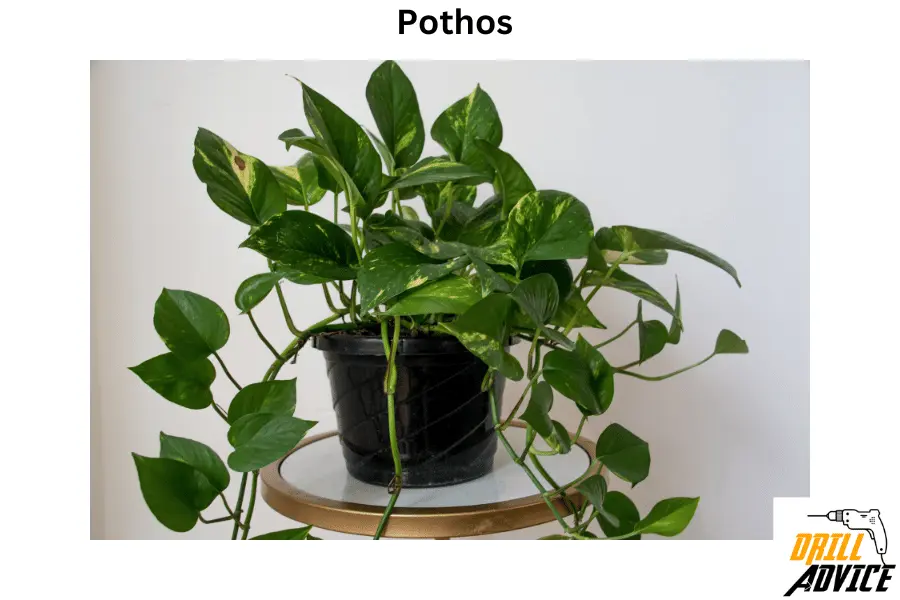
Scientific Name: Epipremnum aureum
Importance of the Plant for Kitchen: Pothos, also known as Devil’s Ivy. Pothos is an ornamental houseplant. It is a versatile and attractive indoor plant that can thrive in various conditions, including kitchens. Its cascading vines and air-purifying abilities make it a popular choice to add a touch of greenery to your kitchen space.
Sunlight Requirement: Pothos can tolerate a wide range of light conditions. It can thrive in low to bright indirect light. Place it near a window with filtered light or on a countertop where it can receive moderate sunlight.
Water Requirement: Pothos has moderate water requirements. Allow the top inch of soil to dry out before watering. Water every 1-2 weeks, adjusting frequency based on the light and humidity levels in your kitchen.
Growing Speed: Pothos is a moderate to fast-growing plant, especially under optimal conditions. Regular pruning can help manage its growth rate.
Color: Pothos has heart-shaped leaves that come in various shades of green, from dark to light. Some varieties have variegated patterns with white or yellow markings.
Growing Place: Place your Pothos on a shelf, countertop, or hanging planter in your kitchen. It’s versatile and can be positioned in various ways to create an attractive display.
Insect Attraction: Pothos is not typically attractive to insects. Its leaves are less likely to be a target for pests due to their thicker texture.
Toxicity: Pothos is considered toxic if ingested, as its leaves contain compounds that can cause mild irritation. It’s essential to keep it out of reach of pets and children.
Pet Friendliness: Pothos is not pet-friendly. While it’s not likely to be lethal if ingested in small quantities, it can cause digestive discomfort and irritation.
Advantages of Having Pothos in the Kitchen:
- Air Purification: Pothos is known for its air-purifying qualities, helping to remove indoor air pollutants and creating a healthier kitchen environment.
- Aesthetic Enhancement: The trailing vines and lush foliage of Pothos can add a refreshing and visually appealing element to your kitchen decor.
- Easy Care: Pothos is forgiving and low-maintenance, making it suitable for beginners or individuals with busy schedules.
Disadvantages of Having Pothos in the Kitchen:
- Toxicity: Pothos can be harmful if ingested, so it’s crucial to keep it out of reach of pets and small children.
- Overgrowth: Pothos can grow quickly, and its vines may become unruly if not regularly pruned or controlled.
- Limited Culinary Use: Pothos is primarily an ornamental plant and is not typically used for culinary purposes.
12. Chinese Evergreen

Scientific Name: Aglaonema spp.
Importance of the Plant for Kitchen: Chinese Evergreen is a popular choice for indoor spaces, including kitchens, due to its adaptability, low maintenance, and attractive foliage. Its lush leaves and air-purifying qualities make it a great addition to create a calming atmosphere in your kitchen.
Sunlight Requirement: Chinese Evergreen can tolerate low to moderate light conditions. It prefers bright, indirect light, so place it near a window with filtered light or in a spot where it can receive ambient light throughout the day.
Water Requirement: Chinese Evergreen has moderate water requirements. Allow the top inch of soil to dry out before watering. Water approximately every 1-2 weeks, adjusting based on the light and humidity levels in your kitchen.
Growing Speed: Chinese Evergreen is a slow to moderate grower. It doesn’t require frequent pruning, but you can remove any yellowing or damaged leaves to maintain its appearance.
Color: Chinese Evergreen’s leaves come in various shades of green, often with variegated patterns of silver, cream, or pink. The colorful foliage can add a subtle touch of elegance to your kitchen.
Growing Place: Position your Chinese Evergreen on a countertop, shelf, or corner in your kitchen where it can receive indirect light. Avoid placing it in direct sunlight, because it can scorch its leaves.
Insect Attraction: Chinese Evergreen is not known to be attractive to insects. Its leaves are typically not a target for pests.
Toxicity: Chinese Evergreen is considered toxic if ingested, as its sap can cause irritation. It’s advisable to keep it out of reach of pets and children.
Pet Friendliness: Chinese Evergreen is not pet-friendly. While it’s not likely to cause severe harm if ingested in small amounts, it can lead to digestive discomfort and irritation.
Advantages of Having Chinese Evergreen in the Kitchen:
- Air Purification: Chinese Evergreen is known for its air-purifying qualities, helping to improve indoor air quality by removing pollutants and toxins.
- Aesthetic Enhancement: The colorful and attractive foliage of Chinese Evergreen can enhance the visual appeal of your kitchen, adding a touch of nature to the space.
- Low Maintenance: Chinese Evergreen requires minimal care and attention, making it suitable for those who have busy lifestyles or are new to plant care.
Disadvantages of Having Chinese Evergreen in the Kitchen:
- Toxicity: Chinese Evergreen is not safe for consumption by pets or humans, so it’s essential to handle it carefully and keep it out of reach.
- Limited Culinary Use: Chinese Evergreen is primarily an ornamental plant and is not typically used for culinary purposes.
- Growth Rate: Chinese evergreens has a slower growth rate.
13. Swedish Ivy
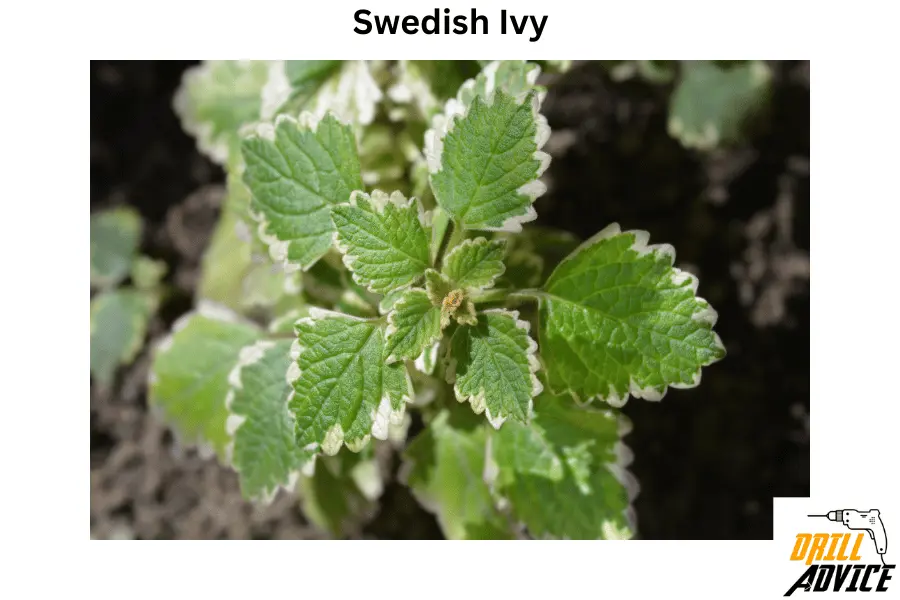
Scientific Name: Plectranthus verticillatus
Importance of the Plant for Kitchen: Swedish Ivy, with its trailing growth and delicate leaves, is a charming choice for adding a touch of greenery to your kitchen. Its low-maintenance nature and attractive appearance make it a lovely decorative element in your culinary space.
Sunlight Requirement: Swedish Ivy prefers bright, indirect light. It can tolerate some direct sunlight, but it’s best to place it in a spot where it can receive filtered light to prevent leaf burn in the kitchen.
Water Requirement: Swedish Ivy has moderate water requirements. Allow the top inch of soil to dry out before watering. Water approximately every 1-2 weeks, adjusting based on the light and humidity levels in your kitchen.
Growing Speed: Swedish Ivy is a moderately fast grower, especially when provided with suitable conditions. Regular pruning can help manage its growth rate.
Color: Swedish Ivy’s leaves are often green, with some varieties having variegated patterns. Its trailing vines and delicate leaves can add a soft and graceful touch to your kitchen decor.
Growing Place: Position your Swedish Ivy in a hanging planter or on a high shelf as it receives bright, indirect light for optimal growth.
Insect Attraction: Swedish Ivy is not typically attractive to insects. Its leaves are less likely to be targeted by pests due to their texture.
Toxicity: Swedish Ivy is considered non-toxic to humans and pets. It is a safe choice for households with curious animals.
Pet Friendliness: Swedish Ivy is pet-friendly and safe for cats and dogs. It’s not likely to cause harm if ingested in small quantities.
Advantages of Having Swedish Ivy in the Kitchen:
- Aesthetic Enhancement: The trailing vines and delicate leaves of Swedish Ivy can add a whimsical and graceful touch to your kitchen, enhancing its overall visual appeal.
- Space Utilization: Swedish Ivy’s trailing growth makes it suitable for hanging planters. This allows you to utilize vertical space in your kitchen.
- Low Maintenance: Swedish Ivy’s needs moderate water and less maintenance.
Disadvantages of Having Swedish Ivy in the Kitchen:
- Growth Rate: Swedish Ivy has a fast growth rate; it might require more frequent pruning to prevent it from becoming overly long and unruly.
- Limited Culinary Use: Swedish Ivy is primarily an ornamental plant and is not typically used for culinary purposes.
- Pruning Maintenance: To maintain its tidy appearance, regular pruning might be necessary as the plant grows.
14. ZZ Plant
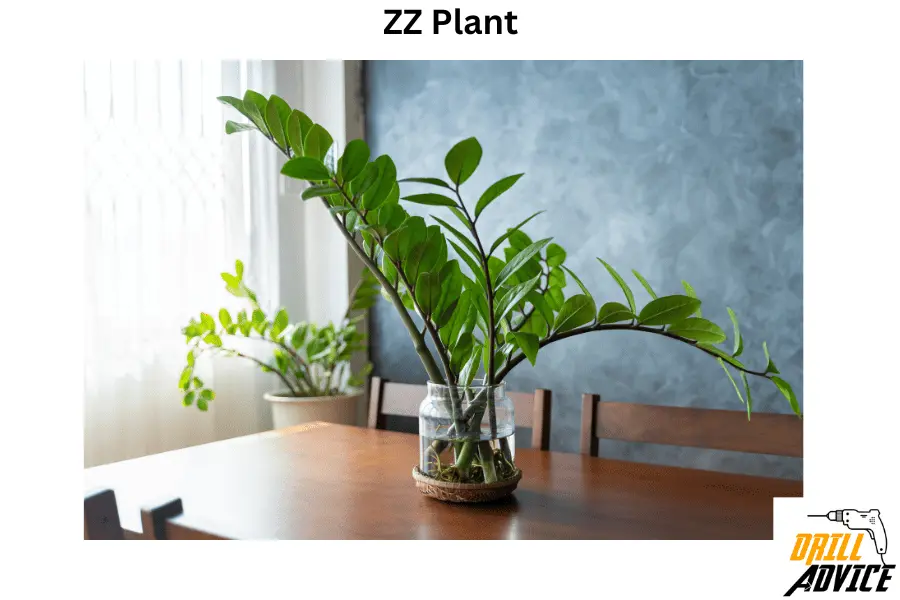
Scientific Name: Zamioculcas zamiifolia
Importance of the Plant for Kitchen: The ZZ Plant, with its striking appearance and low-maintenance nature, is a great choice for adding a touch of modern elegance to your kitchen. Its ability to tolerate low light conditions and its air-purifying qualities make it a popular indoor plant.
Sunlight Requirement: ZZ Plants thrive in low to moderate light conditions. They can tolerate low light and even some fluorescent lighting, making them suitable for kitchens with limited natural light.
Water Requirement: ZZ Plants have low water requirements. Allow the soil to dry out completely between waterings. Water every 2-4 weeks, adjusting frequency based on the light and humidity levels in your kitchen.
Growing Speed: ZZ Plants are slow growers. They produce new leaves infrequently, so you won’t need to worry about frequent pruning or cutting.
Color: ZZ Plants have glossy, dark green leaves that can add a touch of modern sophistication to your kitchen decor.
Growing Place: Position your ZZ Plant on a countertop, shelf, or corner in your kitchen where it can receive low to moderate light. It can tolerate slightly darker spots as well.
Insect Attraction: ZZ Plants are not known to attract insects. Their leaves are relatively thick and not highly appealing to pests.
Toxicity: ZZ Plants are considered toxic if ingested. They contain compounds that can cause discomfort if eaten. It’s advisable to keep them out of reach of pets and children.
Pet Friendliness: While ZZ Plants are not highly toxic, it’s best to keep them away from pets that might chew on plants, as ingestion can lead to mild digestive discomfort.
Advantages of Having ZZ Plant in the Kitchen:
- Low Maintenance: ZZ Plants are highly resilient and require minimal care, making them suitable for beginners or individuals with busy schedules.
- Air Purification: ZZ Plants are effective air purifiers, helping to remove toxins and pollutants from indoor air, creating a healthier kitchen environment.
- Modern Aesthetic: The glossy, dark green leaves of the ZZ Plant can add a touch of modern elegance to your kitchen decor.
Disadvantages of Having ZZ Plant in the Kitchen:
- Toxicity: ZZ Plants can be harmful if ingested, so it’s essential to keep them out of reach of pets and children.
- Limited Culinary Use: ZZ Plants are primarily ornamental and are not typically used for culinary purposes.
- Limited Growth: ZZ plants have a slower growth rate.
15. Air Plant
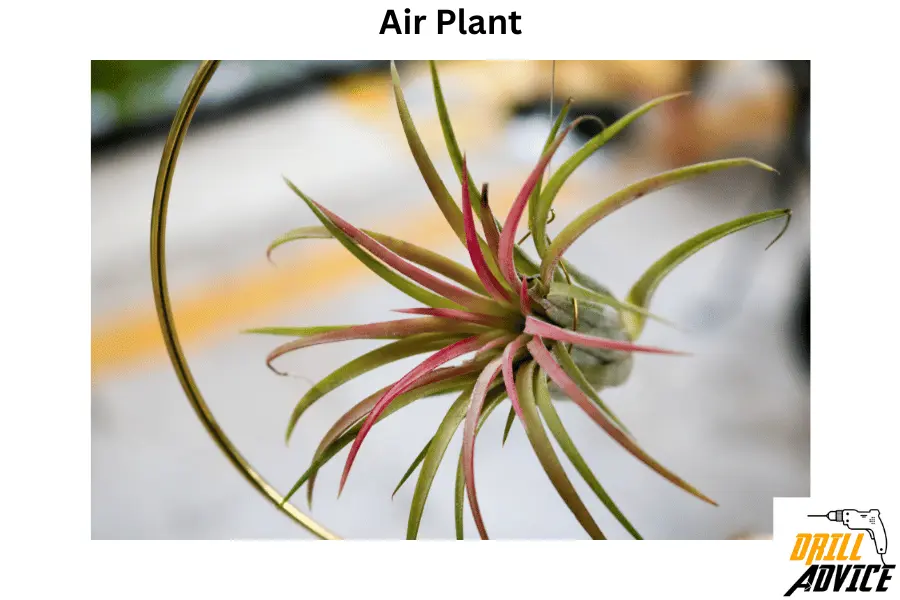
Scientific Name: Tillandsia spp.
Importance of the Plant for Kitchen: Air Plants, also known as Tillandsias, are unique and intriguing plants that require no soil and can be displayed creatively in various ways. Their low-maintenance nature and distinct appearance make them a delightful addition to your kitchen decor.
Sunlight Requirement: Air Plants thrive in bright, indirect light. They can tolerate some direct sunlight, but avoid exposing them to intense afternoon sun. Place them near a window with filtered light or in a spot with good ambient light.
Water Requirement: Air Plants have unique water requirements. Mist or soak them in water once or twice a week, allowing them to dry thoroughly after watering. Adjust the frequency based on the humidity levels in your kitchen.
Growing Speed: Air Plants are slow growers and do not require pruning. They primarily grow new leaves from their center, creating a graceful and captivating appearance.
Color: Air Plants come in various shapes, sizes, and colors, from vibrant green to silvery gray. Their diverse hues and textures can add a touch of nature’s artistry to your kitchen.
Growing Place: Display your Air Plants creatively using holders, hangers, or decorative containers. They can be hung near windows, placed on shelves, or incorporated into unique arrangements.
Insect Attraction: Air Plants are not known to attract insects significantly. Their unique growth habit and lack of soil can make them less appealing to pests.
Toxicity: Air Plants are non-toxic to humans and pets, making them safe to have in your kitchen without concerns for accidental ingestion.
Pet Friendliness: Air Plants are pet-friendly and not toxic to cats, dogs, or other animals.
Advantages of Having Air Plants in the Kitchen:
- Unique Aesthetic: Air Plants’ distinctive shapes and colors can add an artistic and organic element to your kitchen decor.
- Creative Display: Air Plants can be displayed in various creative ways, allowing you to personalize your kitchen space with unique arrangements.
- Low Maintenance: Air Plants are low-maintenance and require minimal care.
Disadvantages of Having Air Plants in the Kitchen:
- Watering Challenge: Air Plants require a unique watering approach (misting or soaking) that might be unfamiliar to some plant enthusiasts.
- Limited Culinary Use: Air Plants are primarily ornamental and are not typically used for culinary purposes.
- Fragility: Air Plants can be delicate, and their unique care requirements might not suit those who prefer more traditional houseplants.
16. Peace Lily
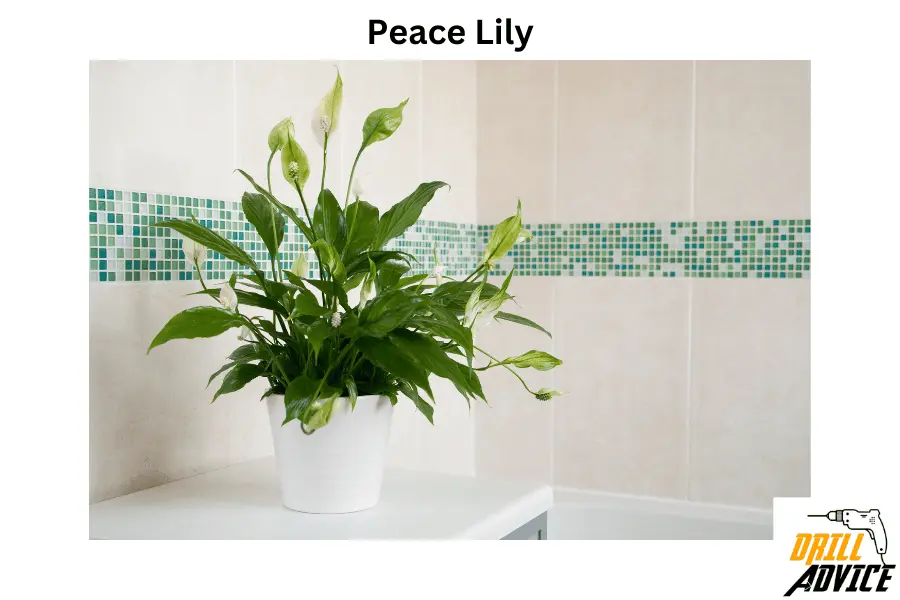
Scientific Name: Spathiphyllum spp.
Importance of the Plant for Kitchen: Peace Lilies are elegant and soothing houseplants known for their graceful white blooms and air-purifying qualities. Their ability to thrive in low-light conditions and their elegant appearance make them a wonderful addition to your kitchen space.
Sunlight Requirement: Peace Lilies thrive in low to moderate light conditions. They prefer bright, indirect light but can tolerate lower light levels, making them suitable for kitchens with limited natural light.
Water Requirement: Peace Lilies have moderate water requirements. Water when the top inch of soil feels dry, typically every 1-2 weeks.
Growing Speed: Peace Lilies are moderate growers. They produce new leaves and flowers throughout the growing season.
Color: Peace Lilies have glossy, dark green leaves and elegant white blooms. Their contrasting colors can add a touch of sophistication to your kitchen decor.
Growing Place: Place your Peace Lily on a countertop, shelf, or corner in your kitchen where it can receive low to moderate light. Avoid placing it in direct sunlight to prevent leaf burn.
Insect Attraction: Peace Lilies are not known to attract insects significantly. Their strong and glossy leaves are less likely to be targeted by pests.
Toxicity: Peace Lilies are considered mildly toxic if ingested. They contain compounds that can cause mild discomfort if eaten. It’s best to keep them out of reach of pets and children.
Pet Friendliness: While Peace Lilies are not highly toxic, they can cause digestive discomfort if ingested. It’s advisable to keep them away from pets that might chew on plants.
Advantages of Having Peace Lily in the Kitchen:
- Air Purification: Peace Lilies are excellent air purifiers, helping to remove toxins and pollutants from indoor air, creating a healthier kitchen environment.
- Elegant Blooms: The beautiful white blooms of Peace Lilies can add a touch of elegance and tranquility to your kitchen decor.
- Low Maintenance: Peace Lilies are relatively easy to care for, making them suitable for individuals with varying levels of plant care experience.
Disadvantages of Having Peace Lily in the Kitchen:
- Toxicity: Peace Lilies can be harmful if ingested, so it’s essential to keep them out of reach of pets and children.
- Flower Sensitivity: Peace Lilies’ blooms are sensitive to changes in light and water conditions. They might wilt if exposed to too much or too little water or light.
- Limited Culinary Use: Peace Lilies are primarily ornamental and are not typically used for culinary purposes.
What Should Not Plant in the Kitchen?
You should not plant in the kitchen related to these categories as toxic to humans and pets, higher maintenance plants, plants prone to pest infestations, larger plants, strong scented plants, higher humidity plants, fruit-bearing plants, spiky or thorny plants in the kitchen.
- Plants Toxic to Humans and Pets:
- Some plants can be harmful or toxic when ingested or touched. These 03 plants, such as Dieffenbachia, Poinsettias, and certain Philodendrons should not plant in the kitchen because they are harmful and toxic to humans and pets.
- High Maintenance Plants:
- Plants that require special care, frequent watering, or specific light conditions can be impractical for a kitchen setting. For example, Orchids, Fiddle Leaf Fig (Ficus lyrata), Boston Fern (Nephrolepis exaltata) might be demanding for some people.
- Plants Prone to Pest Infestations:
- Some plants are more susceptible to pests like spider mites, aphids, or mealybugs. Since the kitchen is a place where hygiene is crucial, you’d want to avoid plants that might attract or harbor pests. An example Hibiscus Gardenia Rose (when grown indoors) would be plants that are already weakened or stressed.
- Plants that Drop Leaves or Debris:
- Plants that tend to shed leaves, flowers, or other debris can create an additional mess in a kitchen. An example Maidenhair Fern (Adiantum), Aidenhair Fern (Adiantum), Weeping Fig (Ficus benjamina), and Cyclamen would be deciduous plants or those nearing the end of their flowering cycle
- Large Plants that Occupy Space:
- Larger plants in the kitchen can obstruct movement, reduce functional space, or risk being knocked over. Plants like Monstera deliciosa (Swiss Cheese Plant) Bird of Paradise (Strelitzia reginae) Rubber Plant (Ficus elastica) are some ideal examples.
- Plants with Strong Scents:
- Strong-scented plants in the kitchen can interfere with the smell of food. Hence these plants such as Jasmine, Gardenia, and Scented Geranium (Pelargonium species) should not plant in the kitchen.
- Plants that Require High Humidity:
- Do not plant high-humidity required plants in the kitchen. Because kitchen activities does not produce high humidity to the plants. Hence you should not plant high range of humidity plants such as Maidenhair Fern (Adiantum), Calathea, and Pitcher Plant (Nepenthes).
- Fruit-bearing Plants:
- It might seem like a great idea to have a fruit-bearing plant in the kitchen, but some might attract pests when they start to bear fruit. Examples could be Dwarf Lemon Tree, Dwarf Banana Plant, and Dwarf Fig Tree.
